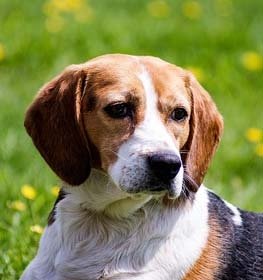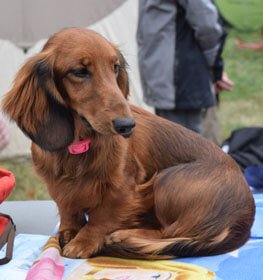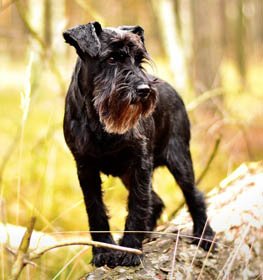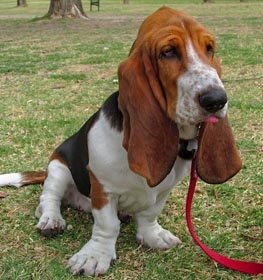Norfolk Terrier Information & Dog Breed Facts
Collection of all the general dog breed info about Norfolk Terrier so you can get to know the breed more.
| Group | Hunting Dogs |
|---|---|
| Popularity Rank | 128 |
| Reviews | 0 |
| User Ratings | |
|
Compare the Norfolk Terrier With Other Dogs
Select at least one dog breed to make the comparsion. | |
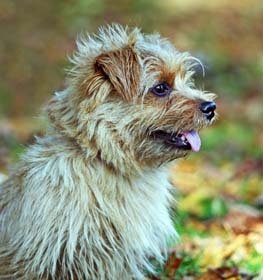 | |
| Origin | |
|
Common Names & Aliases
What other names is a Norfolk Terrier known by? Discover all traditional, regional and informal names used for this breed. | Drop-Eared Norwich Terrier |
|---|---|
|
Breed Classification
What type of dog breed is a Norfolk Terrier? Learn about its genetic classification and breeding category. | Purebred |
|
Size Classification
What size category is a Norfolk Terrier? Learn how big the Norfolk Terrier breed typically grows. | Small |
|---|---|
|
Weight Statistics
How much does a Norfolk Terrier weigh? Discover typical weight ranges for adult males and females of the Norfolk Terrier breed. | 10-12 pounds (4½-5½ kg) |
|
Average Weight
What is the average weight of a Norfolk Terrier? | 11 pounds (5 kg) |
|
Height
How tall is the Norfolk Terrier? Norfolk Terrier height: | 10 inches (25 cm) |
|
Average Height
What is the average height of a Norfolk Terrier? | 10 inches (25 cm) |
|
Price Range
How much does a Norfolk Terrier puppy cost? Find current market prices and factors affecting Norfolk Terrier costs. | $2000-$2500 If you choose to purchase the Norfolk Terrier, you should know that the mentioned amount of money is an average of the collected data from breeders’ sites and puppy finder places. If you have a Norfolk Terrier for sale, please advertise it on a reliable website to make sure the Norfolk Terrier gets to a happy place. |
|---|---|
|
Availability
How easy is it to get a Norfolk Terrier? How many Norfolk Terrier are there in the world? | Frequent: The Norfolk Terrier is easier than average to get. Maybe there is some risk of overbreeding, as it is a popular breed. Due to its popularity, inbreeding may occur. A new study shows that inbreeding contributes to the incidence of disease and health problems. So be careful and seek the help of an experienced person or a professional, in making your decision. |
|
Intelligence Rating
How intelligent is a Norfolk Terrier? Discover the Norfolk Terrier's intelligence ranking and learning capabilities. | Low to average: This canine intelligence is not the brightest one. Keep in mind that if you want to teach them any tricks, they understand and memorize new commands in 40-80 repetitions. Norfolk Terrier obey the first command 30% of the time or better. So if you want to have a smart dog, you might have to reconsider your choice with this breed.
The Norfolk Terrier ranks below average in the intelligence ranking of dogs. |
|---|---|
|
Training Difficulty
How easy is it to train a Norfolk Terrier? Learn about the Norfolk Terrier's trainability and response to training methods. | Norfolk Terrier dogs are quite easy to train. Sometimes they can be challenging, but if you're consistent in teaching new commands they will obey for sure. |
|
Watchdog Rating
How good is a Norfolk Terrier as a watchdog? Learn about the Norfolk Terrier's alertness and guarding instincts. | Norfolk Terrier dogs are average watchdogs. If they sense something different, they will alert you, but observation isn't considered their main job.
|
|
Territorial Protection
Is a Norfolk Terrier protective of its territory? Learn about the Norfolk Terrier's guarding instincts and behavior. | Norfolk Terrier dogs are average defenders. Some dogs are very protective of their territory, while others easily let a stranger to trespass. This breed is not sure to defend its territory in every situation. |
|
Personality Traits
What personality does a Norfolk Terrier have? Learn about characteristic Norfolk Terrier temperament and behavior traits. | HappyIntelligentSelfishFearlessCompanionableSpiritedConfidenceLovable |
|---|---|
|
Sensitivity Level
How sensitive are they? Norfolk Terrier sensitivity: | They are a little bit more sensitive than other dog breeds. Soft punishment affects them emotionally. Norfolk Terrier dogs don't tolerate irregular daily routines, noisy households, and frequent guest visits really well.
They are receptive to their owner's emotions and make wonderful family companions. |
|
Affection Level
How affectionate are they? Is a Norfolk Terrier a good family dog? | Average to High: Norfolk Terrier dogs are highly affectionate dogs. They like being involved in the family's life. This breed isn't considered an aloof dog. |
|
Social Needs
How much social interaction does the Drop-Eared Norwich Terrier need? Norfolk Terrier social needs: | Norfolk Terrier dogs need for social interaction is average. This breed likes being around people or other animals, but they don't mind being left alone for a few hours either. |
|
Impulse to Wander or Roam
How likely is the Norfolk Terrier to run away? Does this breed explore or wander a lot? Does Norfolk Terrier roam? | The wanderlust potential of the Norfolk Terrier is strong enough to escape from home. They have a strong desire for exploring the world. Safer to walk them on a leash unless you teach them how to get back to you on command. |
|
Prey Drive
Do this canine have a strong prey drive? Does Norfolk Terrier have high prey drive? | Their prey drive is low. Norfolk Terrier dogs don't have an impulse to catch or chase small animals. |
|
Barking Frequency
Does a Norfolk Terrier bark a lot? Learn about typical Norfolk Terrier vocalization patterns and triggers. | Average to High: The Norfolk Terrier is a vocal breed. Not the best choice if you prefer a quiet breed. They often bark loudly and howl sometimes. They can change their barks depending on their emotional level and what they're trying to say. Different barks could mean the same and the same barks could have different meanings.
Top reasons for barking: protection, alarm, fear, boredom, attention-seeking, greeting, separation anxiety, compulsive barking. |
|---|---|
|
Playful Nature
How playful is a Norfolk Terrier? Understand the typical play drive and energy level of the Norfolk Terrier breed. | The Norfolk Terrier is a playful breed. Excited barking and sometimes nipping will alert you to play. |
|
Apartment Adaptability
Can a Norfolk Terrier live in an apartment? Learn about the Norfolk Terrier's suitability for apartment living. | Apartment-friendly dog the Norfolk Terrier breed. It is best if you have a small garden where it can occasionally go out to do its business, but this is not important at all. You can exercise him enough with a walk or two a day, so he's comfortable in an apartment. |
|
Lifestyle Adaptability
How adaptable is a Norfolk Terrier to lifestyle changes? Learn about the Norfolk Terrier's flexibility to new situations. | Norfolk Terrier dogs adapt very well to lifestyle changes and basically all living environments. They don't mind moving from one place to another with their owner. |
|---|---|
|
Alone Time Tolerance
Can a Norfolk Terrier be left alone? Learn about the Norfolk Terrier's tolerance to solitude. | Just like every puppy, they are prone to panic, cry, bark, whine when they left alone by their owner. With proper socialization and quality time with the dog can solve this problem. |
|
Bite Risk Assessment
What is a Norfolk Terrier biting potential? Learn about the Norfolk Terrier's bite risk factors. | Low 🔽 The Norfolk Terrier has a low chance of biting somebody. Top reasons for dog bite: protection, pain, excitement, herding instinct, being provoked. (Data based on the available online bite statistics.) |
|---|---|
|
Mouthing Tendency
Is a Norfolk Terrier mouthy? Learn about the Norfolk Terrier's tendency to use mouth during play. | Norfolk Terrier dogs have a lower than average tendency to nip, chew, playbite, or herd people. It's a common habit during puppyhood, not aggressive behavior. These "bites" don't hurt, but Norfolk Terrier dogs need to be taught a good attitude. |
|
Bite Strength Rating
How strong is a Norfolk Terrier bite? Learn about the Norfolk Terrier's bite force measured in PSI. | Between 100 and 200 PSI 🔽 Norfolk Terrier bite force: Weak. The Norfolk Terrier bite force is considered weak when compared to other dog breeds. The bite force Norfolk Terrier measurements usually fall below 200 PSI, making them one of the breeds with the weakest bite force. The bite force of a Norfolk Terrier may be weak, but it's important to remember that any dog's bite can still be dangerous if not managed properly. Despite the bite force of Norfolk Terrier being lower, it does not make them any less lovable or enjoyable as pets.
Norfolk Terrier bite wounds might not be as severe, but it is still essential to be cautious and prevent any biting incidents. They are usually not aggressive and very friendly towards children and other animals. To ensure a well-behaved dog, it's essential to learn how to train a Norfolk Terrier puppy not to bite from an early age. With proper training and socialization, a Norfolk Terrier can be a wonderful addition to any family, providing love and companionship for years to come. |
|
Average Lifespan
How long does a Norfolk Terrier live? Learn about the typical lifespan of the Norfolk Terrier breed. | 11-15 years The average lifespan of Norfolk Terrier: 13 years |
|---|---|
|
Climate Tolerance
How well does a Norfolk Terrier handle different weather? Learn about the Norfolk Terrier's climate adaptability. | Prefers average to cold weather conditions The Norfolk Terrier can adapt to well to cold weather conditions, some dogs even can be a good mountain dog. |
|
Health Concerns
What health issues are common in a Norfolk Terrier? Discover typical conditions affecting the Norfolk Terrier breed. | The Norfolk Terrier is a healthy breed, but there are certain health issues that you should check with your vet regularly. |
|
Vet Care Frequency
How often does a Norfolk Terrier need vet visits? Learn about the Norfolk Terrier's veterinary care requirements. | Average The Norfolk Terrier should have a complete physical check-up at least once per year. If your dog shows any symptoms, call your veterinarian. |
|
Energy Rating
How energetic is a Norfolk Terrier? Understand daily activity needs of the Norfolk Terrier breed. | Norfolk Terrier dogs have a higher energy level than other dog breeds. If you want a dog for snuggling on the couch, this breed isn't the perfect choice for you. |
|---|---|
|
Activity Requirement / Exercise Need
How much exercise does a Norfolk Terrier need? How much exercise do Norfolk Terrier dogs require per day?
Do Norfolk Terrier dogs need a lot of exercises? | Norfolk Terrier dogs need quite a lot of exercise. Daily walks should be on schedule. If you live an active life, this breed can be a good choice for you. |
|
Sleeping Need
How much sleep does the Norfolk Terrier breed need? | Norfolk Terrier dogs are quite energetic dogs and they don't spend too much time with sleeping. If you live an active life, this breed can be a good choice for you. |
|
Obesity Tendency
Is a Norfolk Terrier prone to weight gain? Learn about the Norfolk Terrier's obesity risks. | High: The Norfolk Terrier breed has a strong tendency to be overweight. Try to find the happy medium between exercise and feeding. If you want to keep balance, increase the amount and frequency of your daily dog walk and play with the Norfolk Terrier more often.
If you notice any weight gain, consult your veterinarian and make a diet plan. Reduce unhealthy food and snacks, and measure the Norfolk Terrier weight regularly. |
|---|---|
|
Food Consumption
How much food does a Norfolk Terrier need daily? Learn about the Norfolk Terrier's feeding requirements. | 1/4 to 1/2 cup of high-quality dry food a day, divided into two meals. |
|
Allergy Friendliness
Is a Norfolk Terrier hypoallergenic? Learn about the Norfolk Terrier's suitability for allergy sufferers. | Yes Norfolk Terrier dogs do well with allergy sufferers by causing fewer allergic reaction. However there are no 100% hypoallergenic dogs in the world, there are a variety of breeds that are considered to reduce or minimize the possibility of an allergic response. Coat type isn't necessarily relevant, because most people are allergic to dander (flakes on the dog's skin) or saliva, not actually to dog hair. |
|---|---|
|
Coat Colors
What colors does a Norfolk Terrier come in? Discover all possible Norfolk Terrier color variations. | BlackTan Red Grizzle Wheaten |
|
Grooming Requirements
How much grooming does a Norfolk Terrier need? Learn about Norfolk Terrier coat maintenance requirements. | Average: The Norfolk Terrier requires average grooming effort. Cutting the dog's hair by a professional groomer isn't essential. Brushing the dog's coat is useful to reduce shedding. Ears and eyes should be cleaned regularly to avoid infections. Don't skip the seasonal flea treatment too. Dog nail trimming and dog bath can be helpful sometimes. Check the local pet store for dog grooming supplies and find the best dog shampoo to keep its coat healthy and give your dog a pleasant experience of a dog bath. If you don't have the time, skill, or money to take care of your Norfolk Terrier, search for a dog groomer or clipping service in your area and book an appointment. Maybe you're lucky to have a dog boarding service that includes grooming or walk-in dog bath places nearby. |
|
Drooling Tendency
Does a Norfolk Terrier drool a lot? Learn about the Norfolk Terrier's drooling habits. | The Norfolk Terrier is a perfect example of a very low drooling tendency. If you're disgusted by slobber spots on your clothes, the Norfolk Terrier could be a perfect choice for you. Drooling is the unintentional saliva flowing outside of the mouth. It can be completely normal or a sign of a health problem. Certain dog breeds drool minimum compared to others, just like the Norfolk Terrier.
If you notice any change in your dog's drooling habit, you should contact a vet as soon as possible. |
|
Stinkiness Rating
Does a Norfolk Terrier smell bad? Learn about the Norfolk Terrier's natural odor levels. | Medium ⏺ The Norfolk Terrier has an average chance of bad smell. Top reasons for dog stinkiness: infection of bad tooth/ear/skin folds, gas attacks. |
|
Coat Characteristics
What type of coat does a Norfolk Terrier have? Learn about the Norfolk Terrier's fur characteristics. | WiryShaggy |
|
Bathing Needs
How often does a Norfolk Terrier need baths? Learn about the Norfolk Terrier's bathing requirements. | 8-12 weeks Very rarely. Bathing your dog is beneficial to them in more ways than just one. It’s also a good time to look for unusual scratches, bumps, fleas, and other irregularities. When their hair is wet and flat against their body, these details are more visible.
For example, short-haired dog breeds can go a very long time in between baths. These short-haired breeds shed regularly and that shedding works to naturally remove excess dirt and oil. So unless your weenie dog got into the garbage can, you can probably hold off on a bath for a while. |
|
Shedding Level
How much do Norfolk Terrier dogs shed? How to control, reduce and prevent the shedding of the Drop-Eared Norwich Terrier? Do Norfolk Terrier dogs shed a lot? | Norfolk Terrier dogs shed none to minimal. Having a puppy from this breed you don't have to be afraid of your couch or car being covered by dog hair. Norfolk Terrier dogs could be the best choice if you don't tolerate dog hair. |
|
Child Compatibility
Is a Norfolk Terrier good with children? Learn about the Norfolk Terrier's behavior around kids of different ages. | Norfolk Terrier dogs are kid-friendly dogs. This breed is a good choice if you have children. |
|---|---|
|
Pet Compatibility
How well does a Norfolk Terrier get along with other pets? Discover the Norfolk Terrier's compatibility with other animals. | Norfolk Terrier dogs are usually friendly towards other pets. |
|
Stranger Friendly
Are they aggressive or friendly towards/with strangers? Norfolk Terrier temperament with other people: | Norfolk Terrier dogs are not the most stranger-friendly dogs. |
|
Cat Friendly
How well do Norfolk Terrier dogs get along with cats? Are they good with kittens? What is this fido's temperament with cats? Can they be good with cats? Can the Norfolk Terrier breed live with a cat? | Norfolk Terrier dogs are cat-friendly dogs. |
|
Dog Friendly
Is Norfolk Terrier good with other dogs? Are they dog-friendly dogs? How well do Norfolk Terrier dogs get along with other dogs? | Norfolk Terrier dogs are dog-friendly dogs. If you want more dogs in your family or you'd like to join dog meetups, the Norfolk Terrier can be a great choice. |
|
Good For First Time Owners
Is Norfolk Terrier breed good for first-time owners? Do they make a good dog for novice owners? Is Norfolk Terrier breed suitable for first-time owners? | Yes Norfolk Terrier dogs are good for novice owners, due to their easy-going personality. |
|
Office Friendly
Are Norfolk Terrier dogs good office canines? Do Norfolk Terrier dogs make good office-friendly pets? Can they be office dogs? | No Norfolk Terrier is not the best dog breed for office environment. |
|
Senior Citizens Friendly
Are they senior citizens friendly dogs? How well do Norfolk Terrier dogs get along with the elderly people? What is the Drop-Eared Norwich Terrier temperament with senior people? Are Norfolk Terrier dogs good for elderly owners? | Norfolk Terriers are usually recommended for elderly people. |
|
Service Dog Capability
Can a Norfolk Terrier be a service dog? Learn about the Norfolk Terrier's service work potential. | Not really This breed generally not used as a service dog. A service dog is a term used in the USA to refer to any type of assistance dog specifically trained to help people who have disabilities, such as visual impairment, hearing impairments, mental disorders, seizures, mobility impairment, and diabetes. Service dogs are protected under the ADA (Americans with Disabilities Act).
Norfolk Terrier is not the best breed for service purposes. |
|---|---|
|
Therapy Work Suitability
Is a Norfolk Terrier good as a therapy dog? Learn about the Norfolk Terrier's therapy work aptitude. | Not really This breed is generally not used as a therapy dog. A therapy dog is a dog that might be trained to provide affection, comfort, and love to people in hospitals, retirement homes, nursing homes, schools, hospices, disaster areas, and people with anxiety disorders or autism.
Norfolk Terrier is not the best breed for therapeutic purposes. |
|
Scent Detection Ability
Is a Norfolk Terrier good at detection work? Learn about the Norfolk Terrier's scenting abilities. | Not really They are not typically employed for this type of work, but there may be exceptional cases. A detection dog or sniffer dog is a dog that is trained to use its senses (mostly its smell) to detect substances such as explosives, illegal drugs, wildlife scat, currency, blood, and contraband electronics such as illicit mobile phones.
Norfolk Terrier is not the best breed for detection purposes. |
|
Search & Rescue Potential
Can a Norfolk Terrier do search and rescue? Learn about the Norfolk Terrier's SAR capabilities. | Not really This dog breed is not typically used as a search and rescue dog. The use of dogs in search and rescue (SAR) is a valuable component in wilderness tracking, natural disasters, mass casualty events, and locating missing people.
The Norfolk Terrier is not the best breed for SAR purposes. |
|
Maritime Work Ability
Is a Norfolk Terrier good on boats? Learn about the Norfolk Terrier's maritime capabilities. | Not really Norfolk Terrier breed usually doesn't like being on a boat. Boat dogs were typically bred for their strength, stamina, and water resistance, as they were often required to perform tasks such as pulling in fishing nets, and jumping into the water to retrieve ropes or lines, or helping to move cargo. Sailor dog is a type of dog that was bred to accompany sailors on their voyages. They were typically used for three purposes: as a working dog, a watchdog, and as a companion. A boat dog is a term used to describe a type of dog that was traditionally bred and used as a working dog on boats. |
|
Draft Work Capability
Can a Norfolk Terrier pull carts? Learn about the Norfolk Terrier's drafting abilities. | Not really A drafting dog or draft dog is a dog bred and used for cart pulling. Dogs bred for this work have strong builds and qualities that are needed, strength and determination.
Norfolk Terrier is not the best breed for drafting purposes. |
|
Military Service Background
Was a Norfolk Terrier used in military service? Learn about the Norfolk Terrier's military history. | Not really In history, this breed was not really used for combat dog. |
|
Puppy Litter Size
How many puppies does a Norfolk Terrier usually have? Learn about typical litter sizes. | 2-5 puppies |
|---|---|
|
Pregnancy Duration
How long is a Norfolk Terrier pregnant? Learn about the Norfolk Terrier's gestation period. | 60-64 days Reproductive cycle of the female Norfolk Terrier: The first period called Proestrus lasts for about 9 days.
During this time the females start to attract males. You can notice by swelling vulva and bloody discharge. The second part is the Estrus when the female is receptive for the male. It lasts for about 3 to 11 days. The sign of the proestrus part is the soft and enlarged vulva. The discharge decreases and lightens in color. The third part is the Diestrus. Normally, it occurs around day 14. In this period the female’s discharge changes for vivid red and coming to its end. The vulva returns to average, and she will no longer permit mating. The fourth part called the Anestrus. The time frame between heat periods normally lasts about six months. |
|
Breeding Frequency
How often can a Norfolk Terrier have puppies? Learn about safe breeding intervals. | Once a year. More frequent breeding is not healthy. It is very important not to buy a dog from a puppy mill, where the needs of the pups and their mothers are ignored. It's an inhumane high-volume dog breeding facility, where puppies born several times a year. |
|
AKC Classification
What AKC group is a Norfolk Terrier in? Learn about the Norfolk Terrier's AKC classification. | Recognized by the American Kennel Club in 1979 as a Terrier breed. |
|---|---|
|
FCI Classification
What FCI group is a Norfolk Terrier in? Learn about the Norfolk Terrier's international classification. | Recognized by FCI in the Terriers group, in the Small sized Terriers section. |
Norfolk Terrier Pros and Cons
- Allergy Friendliness: Norfolk Terrier dogs do well with allergy sufferers by causing fewer allergic reaction.
- Apartment Adaptability: Apartment-friendly dog the Norfolk Terrier breed.
- Shedding Level: Norfolk Terrier dogs shed none to minimal.
- Drooling Tendency: The Norfolk Terrier is a perfect example of a very low drooling tendency.
- Mouthing Tendency: Norfolk Terrier dogs have a lower than average tendency to nip, chew, playbite, or herd people.
- Lifestyle Adaptability: Norfolk Terrier dogs adapt very well to lifestyle changes and basically all living environments.
- Child Compatibility: Norfolk Terrier dogs are kid-friendly dogs.
- Cat Friendly: Norfolk Terrier dogs are cat-friendly dogs.
- Dog Friendly: Norfolk Terrier dogs are dog-friendly dogs.
- Senior Citizens Friendly: Norfolk Terriers are usually recommended for elderly people.
- Good For First Time Owners: Norfolk Terrier dogs are good for novice owners, due to their easy-going personality.
- Intelligence Rating: Low to average: This canine intelligence is not the brightest one.
- Obesity Tendency: High: The Norfolk Terrier breed has a strong tendency to be overweight.
- Impulse to Wander or Roam: The wanderlust potential of the Norfolk Terrier is strong enough to escape from home.
- Office Friendly: Norfolk Terrier is not the best dog breed for office environment.
Norfolk Terrier History
The Norfolk Terrier was originally bred to hunt and kill vermin and catch foxes in the early 1800s, because of their sturdy, alert and fearless nature and even temperament.
An English dog breeder named Frank “Roughrider” Jones in the early 20th century developed little red terriers by including several breeds like the Border, Cairn, and Glen of Irish terriers. At first, the Norfolk (ears down) and the Norwich (ears up) terriers were considered to be the same breed. Both of these breeds’ names were originated from near towns in England, Norwich on the Eastside, and Norfolk which lies north of London.
Being originated from the United Kingdom, the little red terriers quickly became a state icon. A Cambridge student, Jodrell Hopkins was one of the early breeders of Norfolk / Norwich terriers, alongside a dog dealer Charles "Doggy" Lawrence, they together bred and sold little red terriers to students. The breed quickly found its fanciers among the students, who used them mainly for catching rats around the colleges and named them Trumpington Terrier, in urban slang, after a street near Cambridge.
Several fanciers began to refine the breed. One of the first exporters of the breed was R. J. Read who later became the president of the Norwich Terrier Club in England.
Phyllis Fagan was another very influential breeder in Norfolk’s history. He acquired a red female terrier named Brownie. Many believe that the Norfolks today are descended from her. Brownie was famous among the terrier community, thanks to her gracious victories in dog shows.
The Norwich and the Norfolk breed were considered to be the same because until the early 1920s both drop-eared and prick-eared dogs were interbred with each other. From the 1930s the two breeds started to diverge. The AKC (American Kennel Club) recognized the breeds in 1936. However, both the United Kingdom and the United States officially recognized Norfolk to be an independent, distinct breed in 1964.
In 1977, The Canadian Kennel Club accepted the Norfolk and the Norwich to be distinct breeds. Two years later, in 1979 the AKC did the same.

